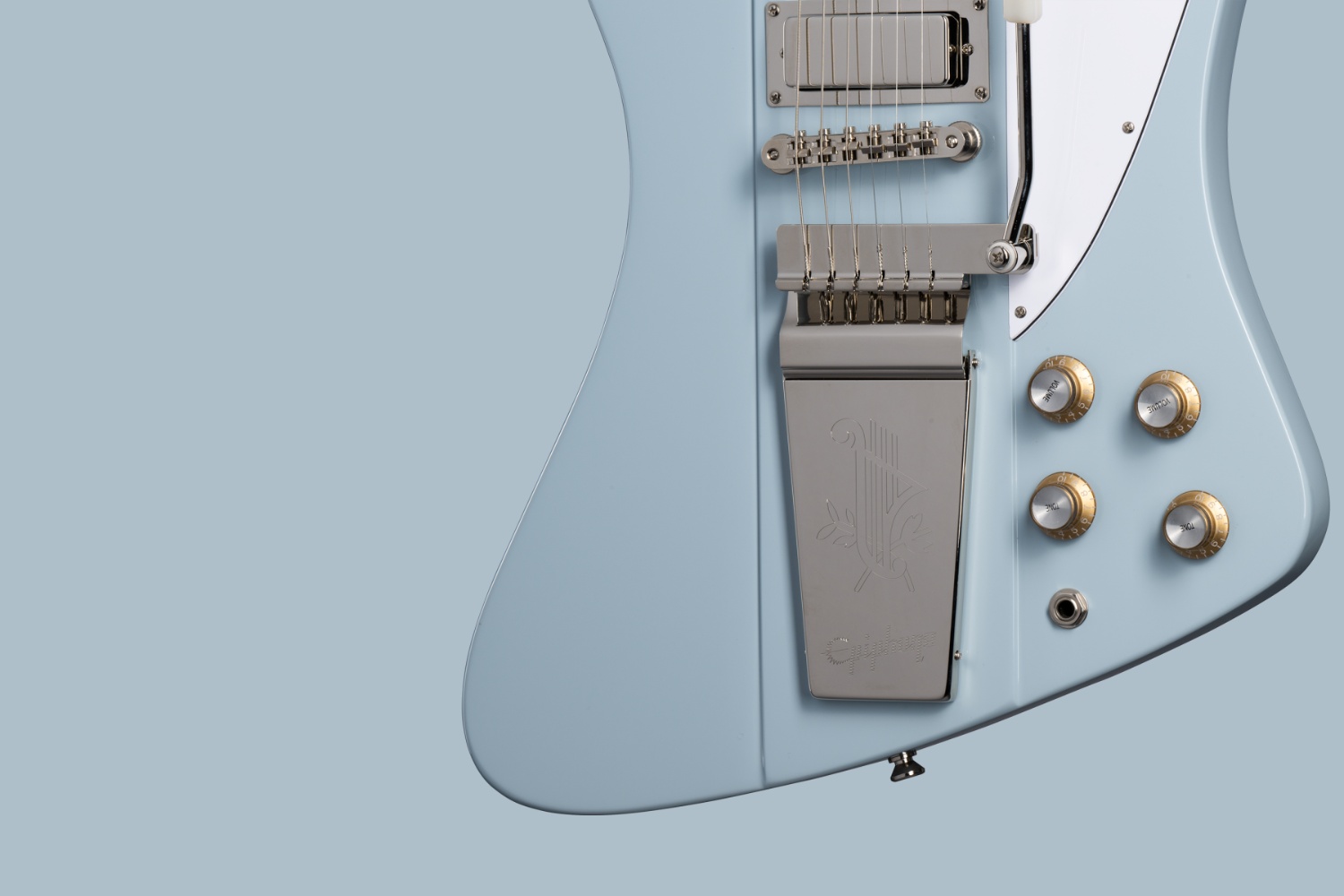The Firebird name and automobile-influenced colours are no coincidence, the Firebird being designed by famous auto-designer Ray Dietrich.
The Epiphone Firebird holds a special place in history, as well as all of our hearts. Production for a new, future-looking model began in 1963, following slow sales of high-priced hollow and semi-hollow Gibsons, as well as the futuristic Explorer, Flying V and Moderne being too extreme for the day.
Epiphone Firebird
The Firebird name and automobile-influenced colours are no coincidence, the Firebird being designed by famous auto-designer Ray Dietrich. Having retired in Kalamazoo, Michigan, Dietrich gave a talk on his expertise regarding auto-design and, inspired, Gibson’s Ted McCarty approached him with a proposition. While unconventional for guitar design (at least in the early 60s), the Firebird is not unlike the Lincolns and Chryslers that Dietrich was known for. The appropriately named Firebird pushed the boundaries and conventions of guitar design at the time, tying together Gibsons’ legacy while elevating it beyond more ’traditional’ shapes and designs.
Read all the latest features, columns and more here.
Colloquially referred to as “Reverse” Firebirds, because the Firebird’s lower, treble-side horn was longer than the other end of its body, the “reverse” Firebirds ironically made the backwards version that would follow a “Non Reverse” Firebird from 1965 onwards.
Whichever way you look at it (literally), the Firebird was the first solid-body Gibson to feature a neck-thru design, bringing with it unmatched sustain and the iconic little hump on the guitar’s body as the neck wood passed through the wings right through to the guitar’s tail. Doing away with Gibson’s naming convention at that time of “Junior”, “Special”, “Custom” and “Standard” models, the Firebird was instead named with roman numerals (I-X, with a few extra models littered in between) to differentiate the more Standard models up to their flagship Custom models. This year, Epiphone pays tribute to two classics: the Firebird I and the Firebird V.
Inspired by Gibson Custom Firebird I
The Epiphone 1963 Firebird I is available in oh-so-60s colours like Heather Poly, Inverness Green and Silver Mist, as well as more traditional colours Vintage Sunburst and Cherry, both exclusively available. Beneath the hood are CTS pots, a Mallory capacitor, and Switchcraft 1/4” output jack, used to control the tone from the single Gibson USA Firebird mini-humbucker, denoting this as a Firebird I and a reasonably lean music machine.
The mini-humbucker falls tonally between a humbucker and a single-coil pickup, doing its job to buck hum, but retaining the cut, bite and jangle of a single-coil. Like the originals, this is a neck-thru design consisting of a nine-ply neck-through-body made of mahogany and walnut, with mahogany wings. Kluson planetary geared “banjo” tuners complete the look, just like they did in the 60s, giving the Firebird its unique silhouette. The tuners serve both to provide sleek aesthetics as well as stable tuning, the mechanism itself serving to securely retain string tension with smooth and accurate tuning.
Inspired by Gibson Custom Firebird V
The Firebird V builds on everything that the Firebird I offers, moving quickly past the double-humbucker’d Firebird III, the V featuring two mini humbuckers and a Maestro Vibrola to express yourself and modulate to your heart’s content. The 1963 Epiphone Firebird V specifically, though, features a newly redesigned Vibrola with engraved Epiphone logo
The Epiphone 1963 Firebird V includes the same Gibson USA Firebird mini humbucker pickups as the Firebird I, again with Alnico 5 magnets, each pickup having its own volume and tone control.
The Epiphone Firebird V combines modern tech and vintage flair, with Epiphone ABR-1 bridge to maintain tuning stability. The Firebird I has a period-correct Wraparound Lightning Bar bridge.
The Firebird is as much a part of guitar history as any other, its eye catching, head turning “reverse” body shape helping to push guitar design forward. The sustain available from the neck-thru design offers new tonal possibilities, with the mini humbuckers offering a unique middle ground between the single-coil or humbucking camps. While its aesthetic design is enough to ogle at, the players who’ve trusted it speak to its ability to handle just about any task you need it to.
Various iterations of Firebirds have been strung across the shoulders of the likes of Jamie Cook of the Arctic Monkeys and Lzzy Hale, along with her Explorerbird Explorer/Firebird hybrid. Dave Grohl famously played a Pelham Blue Firebird Studio, and had an artist’s signature model made, while Tom Petty rocked with one for decades, along with his guitarist Mike Campbell.
The Firebird borrows from the best that Gibson had at the time, opting for a slimmer, more lightweight body than the Les Pauls that had come before it, and refined the design for the modern day. Epiphone’s 1963 Firebird I and Firebird V pay tribute to this in the best way: an affordable package and a stellar offering of guitars. The Firebird I is your workhorse, providing a stable rock stalwart that’s all tone, while the Firebird V adds a mini humbuckers and vibrato system, allowing you to subtly or overtly shape and hone your tone, all the whole expressing yourself with vibrato and whammy. The Firebird truly is a part of musical history.
Find your nearest Epiphone dealer.







